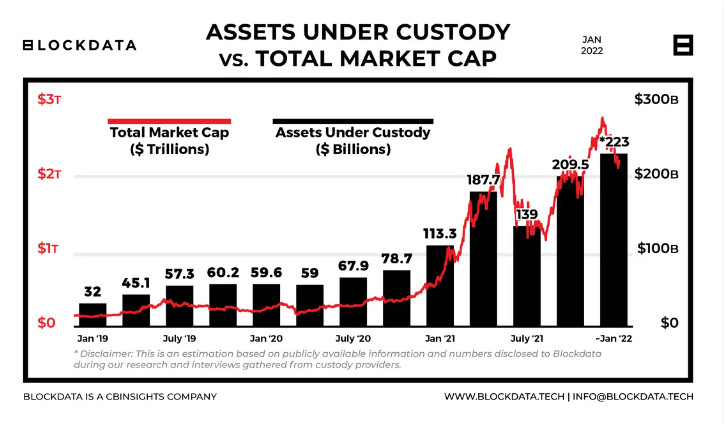Between August 2021 and May 2022, a good number of the financial giants made investments in crypto-blockchain entities. And they didn’t go there with the back of a spoon. (Click on the image below to zoom)
Source: Blockdata
By looking at the details of the investments made, we can examine the total financing amounts of the funding rounds in which they participated. Based on this, the active investors in the largest financing rounds are Morgan Stanley ($1,100m in 2 rounds), Goldman Sachs ($698m in 5 rounds), BNY Mellon ($690m in 3 rounds) , Commonwealth Bank of Australia ($421m in 4 rounds) and Citigroup ($215m in 6 rounds).
Between August 2021 and May 2022, a total of 61 banks have invested in the crypto-blockchain space at least once. Consequently, the gradual entry of new institutional investors suggests a stable long-term outlook for the Web3 ecosystem and should, potentially, lead to an increasing participation of the banking sector in the next fundraisings linked to blockchain entities. I will not fail to share with you the next publications of the participations in the rounds of these financial institutions.
In which sectors do these banks invest the most?
Custody Solutions and Technology Providers
Custody solutions and blockchain technology providers are growing in popularity among top banks, some having raised the largest funding rounds since August 2021. These include: NYDIG ($1 billion), Fireblocks ($550 million), Gemini ($400 million), and Anchorage Digital ($350 million).
This comes as no surprise as the market cap value of cryptocurrencies hit an all-time high in November 2021, leading to an increase in demand and the amount of digital assets held by custodial providers. . Between 2019 and the start of 2022, assets under custody (AUC) increased by just under 700%.

Assets under custody (AUC)
Red curve = crypto market capitalization
Blockdata
There is very clearly a correlation between the evolution of the cryptocurrency market and the assets held by centralized entities over recent years. The next publications of the assets under custody (AUC) of these entities will probably indicate a fall in the weight of these AUC in the wake of the tumble of the crypto market over this first half. As a reminder, the digital asset market has lost 55% of its value since January 1, 2022.
blockchain infrastructure
Morgan Stanley’s investment in the blockchain infrastructure and services company, figure, highlights the importance of staking decentralized protocols, middleware, and application-level solutions in the Web3 ecosystem. Figment basically focuses on strengthening the crypto ecosystem by increasing the adoption of Proof of Stake (PoS) blockchains (a consensus mechanism to validate and secure transactions on a blockchain) which opposes blockchains under the Proof mechanism of Work (like Bitcoin for example). The company works in particular with the French nugget Ledger and many layers of blockchain infrastructures such as Ethereum, Solana, Avalanche, Polygon, Cardano, Cosmos…
Talos, another emerging digital asset and crypto-trading infrastructure provider, has caught the eye of Wells Fargo Strategic Capital, BNY Mellon and Citi Ventures. Talos has become particularly popular among banks due to its plans to extend centralized crypto trading support to decentralized finance (DeFi) platforms. Although these have been roughed up in recent weeks.
Blackdaemonis another blockchain infrastructure company focused on managing and staking nodes (computers connected to a blockchain to validate transactions and secure the network) raised funds across multiple funding rounds from Citi Ventures, which participated to the Series C of the investment round and JP Morgan Chase and Goldman Sachs who invested in their Series B round.
Their presence and investments in this space highlights their focus on the continued development of blockchain infrastructure tools and services needed to support the growing crypto ecosystem. I am concocting a focus on each of these Web3 infrastructures to dissect their business model and their added value in the banking ecosystem. You will quickly find these focuses in the columns of Zonebourse.
Other areas on the finance giants’ radar
Overall, banks are investing in a variety of areas ranging from blockchain development platforms, asset exchanges, market intelligence services and decentralized applications. Most of these investments are aimed at accelerating the growth of user adoption, technology innovation and customer experience in the immediate future.
In entities that have obtained investments from banks, we can cite asset management/tokenization marketplaces such as Buysell Standards. In Europe, we can cite the Swiss-based cryptocurrency custody specialist Metaco, which has signed a partnership with Société Générale.
Crédit Agricole Italia, for its part, has invested in the funding round of the Italian start-up blockinvestan asset tokenization company that digitizes the process of issuing and selling real estate and bonds.
Commonwealth Bank of Australia has announced plans to integrate Gemini’s crypto exchange and custody service into its mobile banking application, CommApp, via APIs.
US Bank announced its partnership with NYDIG to provide bitcoin custody services available to their institutional investment managers with private funds in the United States or the Cayman Islands.
We are also watching crypto data providers like Corner Metrics supported by Goldman Sachs and BNY Mellon or even entities that aim to secure blockchain infrastructures against fraud and illicit transactions such as Certik.
Banks: the cornerstone of the mass adoption of Web3?
While some banks are taking an active approach by investing in companies providing blockchain and cryptocurrency infrastructure services, some are adopting a wait-and-see strategy as current regulations prevent them from unwillingly engaging in this space. That being said, in 2021, 8% of the total patents granted by the BoA were related to blockchain, with banking seeing 86% growth in this core patent category. Figures that relate the significant commitment of banks in blockchain infrastructures to optimize their services
These initiatives show that banks no longer see Web3 as a real threat. Which was still the case a few months ago. As we have just seen, some banks have already started integrating blockchain and crypto solutions into their traditional banking portfolio as an integrated or additional option.
Once regulations surrounding the cryptosphere become clearer, more traditional and still reluctant financial institutions will inevitably seek to integrate blockchain and crypto solutions, which will drive mainstream adoption. Provided that regulation and regulation are, of course, favorable for the development of Web3 ecosystem services, especially for decentralized finance (DeFi).
